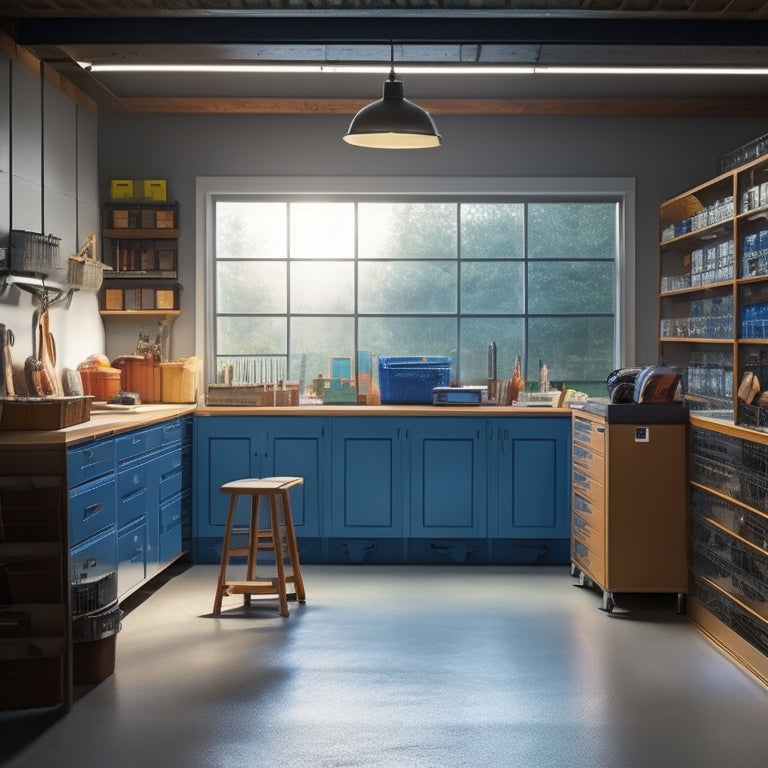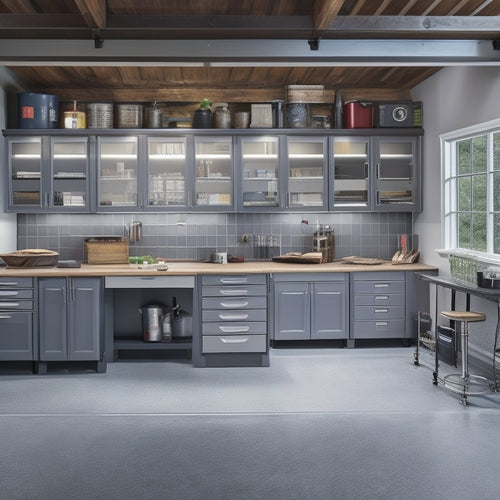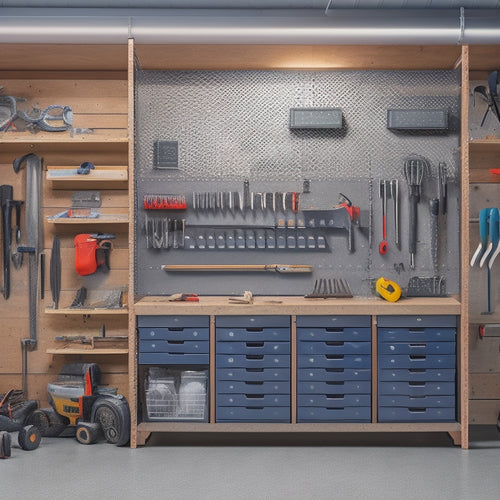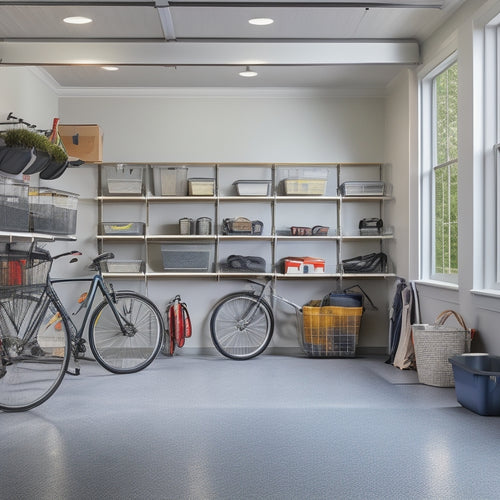
7 Essential Tips for a Clutter-Free Garage
Share
You'll get started on your clutter-free garage by purging unnecessary items, identifying what to donate, sell, or discard. Next, categorize items into groups like tools and seasonal items, and assign a home for each category using storage bins, cabinets, and wall-mounted hooks. Maximize vertical storage space with shelves and hooks, and optimize your work zone by positioning tools and equipment for efficiency. Implement a maintenance schedule to keep your garage organized, and store seasonal items out of sight. As you tackle these essential tips, you'll uncover more opportunities to create a space that truly works for you.
Key Takeaways
• Identify and remove unnecessary items to free up space and establish a Donation Station for items to be donated or sold.
• Categorize items into groups like tools, seasonal items, and project materials, and utilize project bins and designated areas for specific themes.
• Assign specific storage spaces for each category of items, using storage bins, garage cabinets, and wall-mounted hooks for organization.
• Maximize vertical storage with shelves, hooks, and slatwalls to keep the garage floor clear and incorporate hidden compartments for valuable items.
• Strategically position tools, equipment, and workspace for efficiency, designing a workbench layout that suits your tasks and prioritizing must-haves to avoid procrastination.
Purge Unnecessary Items First
Before you can organize your garage, start by getting rid of anything you no longer need, use, or love, as unnecessary items are the biggest obstacle to a clutter-free space. Be honest with yourself - when was the last time you used that old bike or those rusty tools? If you can't remember, it's probably safe to let them go.
Set up a Donation Station in your garage to collect items you can donate or sell. This won't only declutter your space but also give you a sense of fulfillment knowing you're helping others.
Letting go can be tough, especially when emotional attachment is involved. That old trinket your grandpa gave you might hold sentimental value, but if it's broken or no longer serves a purpose, consider taking a photo of it and letting it go.
Categorize and Group Similar Items
Now that you've purged your garage of unnecessary items, it's time to categorize and group similar items together, making it easier to see what you have and where it should be stored. This step is essential in maintaining a clutter-free garage. By grouping similar items, you'll be able to identify what you have, what you need, and what you can get rid of.
Here are some ways to categorize and group similar items:
-
Tools: Group hand tools, power tools, and automotive tools into separate categories.
-
Seasonal items: Store summer and winter gear, such as bikes, lawn equipment, and winter sports equipment, in designated areas.
-
Project bins: Use bins to store items related to specific projects, like woodworking or crafting supplies.
-
Item themes: Group items by theme, such as camping gear, sporting equipment, or gardening tools.
-
Frequently used items: Store frequently used items in easy-to-access locations, like near the garage door or on a pegboard.
Assign a Home for Each Item
Now that you've grouped similar items together, it's time to assign a home for each item in your garage.
You'll need to designate specific storage spaces and zones for each category, making it easy to find what you need when you need it.
Designate Storage Spaces
Assign a designated storage space for each item, ensuring everything has a specific 'home' within the garage, making it easier to find what you need and preventing clutter from building up in the future. This way, you'll avoid wasting time searching for misplaced items and reduce stress.
To effectively designate storage spaces, consider the following:
-
Use Storage Bins to store items like seasonal decorations, out-of-season clothing, and sporting equipment. Label each bin so you know what's inside.
-
Install Garage Cabinets to store items like tools, cleaning supplies, and other essentials. Look for cabinets with adjustable shelves to maximize storage.
-
Designate a specific area for larger items like bikes, lawn mowers, and other equipment.
-
Utilize wall-mounted hooks and baskets to store items like helmets, bags, and accessories.
-
Reserve a specific area for items you use frequently, like gardening tools or pet supplies, so they're easily accessible.
Label and Sign Zones
You'll make the most of your designated storage spaces by labeling and signing each zone, so you can quickly identify where items belong and maintain your garage's organization. This step is essential in assigning a home for each item, making it easy to find what you need when you need it.
Start by defining zone boundaries, which will help you create a visual distinction between different areas of your garage. Use signage to identify each zone, creating a hierarchy that makes sense to you. For example, you might've a 'Tool Zone' with subzones for 'Power Tools' and 'Hand Tools.' Use clear, concise language on your signs, and consider adding icons or images to help you quickly identify each zone.
Utilize Vertical Storage Space
Take advantage of your garage's ceiling height by installing shelves, hooks, or a slatwall to maximize your vertical storage space. This will help keep your garage floor clear and create more room for your vehicles or workspace.
By utilizing vertical storage, you can store items like bikes, kayaks, or seasonal decorations out of the way but still easily accessible.
Here are some ideas to get you started:
-
Install adjustable shelves to accommodate items of different sizes
-
Use hooks to hang items like bikes, tools, or accessories
-
Add a slatwall with bins and baskets to store small items like nuts and bolts or cleaning supplies
-
Incorporate hidden compartments, like a storage cabinet or a secret shelf, to stash valuable or sensitive items
-
Consider a ceiling-mounted storage rack for infrequently used items like luggage or camping gear
Optimize Your Garage's Work Zone
Transform your garage's work zone into a productivity powerhouse by strategically positioning your tools, equipment, and workspace to reduce clutter, increase efficiency, and make the most of your time. To achieve this, start by designing a workbench layout that suits your needs. Consider the tasks you perform most frequently and place the necessary tools and equipment within easy reach. This will save you time and energy by minimizing walking distances and reducing the need to constantly switch between tools.
Next, prioritize your tasks by categorizing them into must-haves, should-haves, and nice-to-haves. Focus on completing the must-haves first, and then move on to the less pressing tasks. This task prioritization will help you stay focused and avoid procrastination.
Implement a Maintenance Schedule
Now that you've organized your garage, it's essential to maintain the space to prevent clutter from building up again.
You'll want to implement a maintenance schedule to stay on top of tasks and keep your garage clutter-free.
Set Reminders Regularly
Set reminders on your calendar to tackle garage organization tasks at regular intervals, ensuring your space stays clutter-free and functional. By doing so, you'll develop a habit of regular maintenance, which is essential for keeping your garage organized. This habit formation will help you stay on top of clutter and prevent it from building up again.
Here are some tasks to include in your reminders:
-
Monthly: Take 30 minutes to tidy up and put away items that are out of place.
-
Quarterly: Dedicate a few hours to deep cleaning and organizing specific areas, such as your tool bench or storage shelves.
-
Bi-annually: Inspect and maintain your garage's systems, including the HVAC and electrical systems.
-
Annually: Set aside a day to tackle major organizational projects, like reorganizing your storage or installing new shelving.
-
As needed: Schedule reminders to restock supplies, replace filters, or perform other tasks that require attention.
Schedule Seasonal Tasks
You'll also want to schedule seasonal tasks to maintain your garage's organization and functionality throughout the year. This will guarantee that your space stays clutter-free and efficient, even as the seasons change.
Start by identifying your task priorities, such as cleaning out winter gear in the spring or preparing your summer toys for storage in the fall. Once you have your tasks, block out dedicated time on your calendar for each one. This is called calendar blocking, and it's a great way to stay on track and avoid procrastination.
Be realistic about how much time each task will take, and don't be afraid to break larger tasks into smaller, more manageable chunks. By scheduling seasonal tasks, you'll be able to stay ahead of clutter and keep your garage running smoothly all year round.
Plus, having a clear plan will give you peace of mind and make the task less overwhelming. So, take a few minutes to plan out your seasonal tasks today and enjoy a clutter-free garage all year long!
Store Seasonal Items Out of Sight
You're taking the right steps towards a clutter-free garage! Now, let's tackle storing seasonal items out of sight. Three to four storage bins labeled by season can help keep items like holiday decorations, out-of-season clothing, and summer toys organized and hidden from view.
Here are some additional tips to maximize your off-season storage:
-
Designate a specific area for off-season storage bins, keeping them out of the way but still accessible.
-
Consider installing hidden shelves or compartments for extra storage.
-
Use bins with clear labels, so you can easily identify what's inside without having to dig through.
-
Store items that are used infrequently, like winter clothing or holiday decorations, in harder-to-reach areas.
-
Keep frequently used items, like summer toys or camping gear, in easy-to-access locations.
Frequently Asked Questions
How Do I Deal With a Cluttered Garage That's Overwhelming to Organize?
You're standing in your cluttered garage, feeling overwhelmed - don't. Start small, focusing on one area at a time. Break habits by creating new routines, and slowly, you'll tame the chaos, regaining control over your space.
What if I Have Limited Space for Storage and Shelving Units?
Your garage's cramped quarters can feel like a suffocating vise, but don't let it squeeze the life out of your organizing dreams! You're forced to think outside the box, optimizing layout and creatively repurposing spaces to maximize storage.
Can I Use My Garage for Both Storage and a Home Gym or Office?
You can definitely create a shared space in your garage that serves a dual purpose - think storage and home gym or office. Start by designating zones and using space-saving furniture to maximize functionality.
How Often Should I Clean and Dust My Garage Storage Containers?
You should clean and dust your garage storage containers every 2-3 months to maintain a clutter-free space. Create a dusting schedule to guarantee consistent container maintenance, and adjust as needed based on usage and environmental factors.
Are There Any Eco-Friendly Storage Options Available for Garage Organization?
You're looking for eco-friendly storage options, and you'll be glad to know that yes, there are! Opt for sustainable materials and recycled containers that reduce waste, like repurposed wooden crates or bins made from recycled plastic.
Related Posts
-

Best Tool Chests for Home Garage Options
When selecting the best tool chest for your home garage, you'll want to evaluate top brands like DeWalt, Milwaukee, a...
-

Building a Wall Tool Storage System
You're about to create a customized wall tool storage system that streamlines your workflow. Start by clearing your w...
-

Bin Garage Storage Ideas for Maximizing Space
You can greatly maximize your garage's storage space by utilizing vertical space with ceiling storage bins, stacking ...


